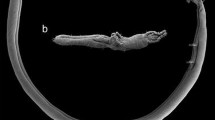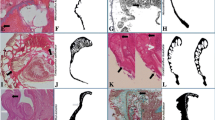Abstract
Most myzostomids are ectocommensals of crinoids on which they move freely. Their locomotion is ensured by five pairs of parapodia located laterally below their trunk. Each parapodium in Myzostoma cirriferum is a conical structure that includes a hook-like chaeta, replacement chaetae and an aciculum. Structure and ultrastructure of the myzostomid chaetae are similar to those of polychaetes: they are formed by a chaetoblast, which gives rise to microvilli where chaetal material is assembled on the outer surface. Myzostoma cirriferum walks on its host. It moves the anterior part, the posterior part or the lateral parts forwards but is able to rotate of 180° on itself. Its locomotion entirely depends on parapodial motions and not on trunk movements. Three pairs of muscles are involved in parapodial motions: parapodium flexor and parapodium extensor, aciculum protractor and aciculum retractor, and hook protractor with conjunctor. A functional model is proposed for explaining the global motion of a parapodium in M. cirriferum that may be extended to all ectocommensal myzostomids.






Similar content being viewed by others
References
Bleidorn C, Eeckhaut I, Podsiadlowski L, Schult N, McHugh D, Halanych KM, Milinkovitch MC, Tiedemann R (2007) Mitochondrial genome and nuclear sequence data support Myzostomida as part of the annelid radiation. Mol Biol Evol 24(8):1690–1701
Eeckhaut I, Jangoux M (1993) Integument and epidermal sensory structure of Myzostoma cirriferum (Myzostomida). Zoomorphology 113:33–46
Eeckhaut I, Lanterbecq D (2005) Myzostomida: a review of the phylogeny and ultrastructure. In: Bartolomaeus T, Purschke G (eds) Morphology, molecules, evolution and phylogeny in polychaeta and related taxa. Springer, Berlin, pp 253–275
Eeckhaut I, McHugh D, Mardulyn P, Tiedemann R, Monteyne D, Jangoux M Milinkovitch MC (2000) Myzostomida : a link between trochozoans and flatworms? Proc R Soc London B 267:1383–1392
Eeckhaut I, Fievez L, Müller MC (2003) Larval development of Myzostoma cirriferum (Myzostomida). J Morphol 258:269–283
Graff L (1877) Das Genus Myzostoma (F.S. Leuckart). Wilhelm Engelmann, Leipzig
Grygier MJ (2000) Class myzostomida. In: Beesley PL, Ross GJB, Glasby CJ (eds) Polychaetes and allies: the southern synthesis. Fauna of Australia, Vol. 4A Polychaeta, Myzostomida, Pogonophora, Echiura, Sipuncula. CSIRO Publishing, Melbourne, pp 297–330
Haszprunar G (1996) The mollusca: coelomate turbellarians or mesenchymate annelids? In: Taylor JD (ed) Origin and evolutionary radiation of the mollusca. Oxford University Press, Oxford, pp 3–28
Hausen H (2005) Chaetae and chaetogenesis in polychaetes (Annelida). In: Bartolomaeus T, Purschke G (eds) Morphology, molecules, evolution and phylogeny in polychaeta and related taxa. Springer, Berlin, pp 37–52
Humphrey CD, Pittman FE (1974) A simple methylene blue-azureII-basic fuchsin stain for epoxy-embedded tissue sections. Stain Technol 49:9–14
Jägersten G (1936) Zur Kenntnis der Parapodialborsten bei Myzostomum. Zool Bidr fran Uppsala 16:283–299
Lüter C, Bartolomaeus T (1997) The phylogenetic position of Brachiopoda—an analysis of morphological and molecular data. Zoologica Scripta 26:245–253
Müller MC, Westheide W (2000) Structure of the nervous system of Myzostoma cirriferum (Annelida) as revealed by immunohistochemistry and cLSM analyses. J Morphol 245:87–98
Passamaneck Y, Halanych KM (2006) Lophotrochozoan phylogeny assessed with LSU and SSU data: evidence of Lophophorate Polyphyly. Mol Phylogenet Evol 40:20–28
Rouse GW, Fauchald K (1997) Cladistics and polychaetes. Zool Scr 26:139–204
Rouse GW, Pleijel F (2006) Annelid phylogeny and systematics. In: Rouse GW, Pleijel F (eds) Reproductive biology and phylogeny of Annelida. Vol 4 of series: reproductive biology and phylogeny. Science Publishers, Enfield NH, pp 3–21
Stummer-Traunfels RR von (1926) Myzostomida. In: Kükenthal W (ed) Handbuch der Zoologie, vol 3. De Gruyter, Berlin
Zrzavy J, Hypsa V, Tietz D (2001) Myzostomida are not annelids: molecular and morphological support for a clade of animals with anteriorsperm flagella. Cladistics 17:1–29
Acknowledgments
C. Bleidorn was financially supported by the Deutsche Forschungsgemeinschaft in the priority program SPP 1174 “Deep Metazoan Phylogeny” (TI 349/4-1). Deborah Lanterbecq is supported by the “Fonds de la Recherche Scientifique (FNRS)”. The researches were supported by FRFC contract no 2.4.567.04.F
Author information
Authors and Affiliations
Corresponding author
Rights and permissions
About this article
Cite this article
Lanterbecq, D., Bleidorn, C., Michel, S. et al. Locomotion and fine structure of parapodia in Myzostoma cirriferum (Myzostomida). Zoomorphology 127, 59–68 (2008). https://doi.org/10.1007/s00435-007-0052-2
Received:
Revised:
Accepted:
Published:
Issue Date:
DOI: https://doi.org/10.1007/s00435-007-0052-2




